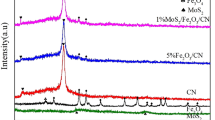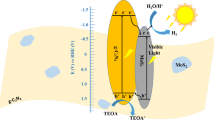Abstract
The new composite MoS2/CeO2–Co3O4 showed high efficiency of hydrogen evolution under visible light irradiation, and the synthesis and properties of photocatalyst were also introduced in this paper. The hydrogen evolution of 1%MoS2/CeO2–Co3O4 catalyst reached 221 μmol in 3 h, and the catalyst still exhibited high activity after 12 h under visible light irradiation of 10%TEOA solution, which indicates that the photocatalyst had excellent photocatalytic activity and light stability. The analysis of XRD, XPS, SEM and TEM showed that MoS2/CeO2–Co3O4 was successfully synthesized. The analysis of BET showed the specific surface area of photocatalyst composite increased due to the addition of CeO2 and MoS2, which was good for EY adsorption, accelerated the electron transfer rate and improved the production of hydrogen. The PL and electrochemical analysis results showed that CeO2–Co3O4 loaded on the surface of MoS2 nanoparticles can significantly promote electron transfer, restrain the recombination of electron and hole and improve the rate of hydrogen production. Therefore, the oxide of the rare-earth element Ce and Co3O4 might be good for the design of a new photocatalyst.











Similar content being viewed by others
References
Carrette L, Friedrich KA, Stimming U (2015) Fuel cells—fundamentals and applications. Fuel Cells 1:5–39
Liu W, Shang Y, Zhu A, Tan P, Liu Y, Qiao L (2017) Enhanced performance of doped BiOCl nanoplates for photocatalysis: understanding from doping insight into improved spatial carrier separation. J Mater Chem A 5:12542–12549
Lv Z, Mahmood N, Tahir M, Pan L, Zhang X, Zou JJ (2016) Fabrication of zero to three dimensional nanostructured molybdenum sulfides and their electrochemical and photocatalytic applications. Nanoscale 8:18250
Zhang R, Zhang YC, Pan L, Shen GQ, Mahmood N, Ma YH (2018) Engineering cobalt defects in cobalt oxide for highly efficient electrocatalytic oxygen evolution. Acs Catalysis 8:3803–3811
And SK, Raftery D (2016) Visible light driven V-doped TiO2 photocatalyst and its photooxidation of ethanol. J Phys Chem B 105:2815–2819
Zhang S, Tang F, Liu J, Che W, Su H, Liu W (2017) MoS2-coated ZnO nanocomposite as an active heterostructure photocatalyst for hydrogen evolution. Radiat Phys Chem 137:104–107
Saravanakumar K, Karthik R, Chen SM, Vinoth KJ, Prakash K, Muthuraj V (2017) Construction of novel Pd/CeO2/g–C3N4 nanocomposites as efficient visible-light photocatalysts for hexavalent chromium detoxification. J Colloid Interface Sci 504:514–526
Han C, Lei G, Chen C, Li Y, Xiao X, Zhang Y (2014) Novel visible light induced Co3O4–g–C3N4 heterojunction photocatalysts for efficient degradation of methyl orange. Appl Catal B 147:546–553
Zeng B, Hui L (2015) Three-dimensional porous graphene–Co3O4, nanocomposites for high performance photocatalysts. Appl Surf Sci 357:439–444
Hao X, Jin Z, Lu G (2016) Enhanced surface electron transfer with the aid of methyl viologen on the Co3O4–g–C3N4 photocatalyst. Chem Lett 45:116–118
Liotta LF, Carlo GD, Pantaleo G, Venezia AM, Deganello G (2006) Co3O4/CeO2 composite oxides for methane emissions abatement: relationship between Co3O4–CeO2 interaction and catalytic activity. Appl Catal B 66:217–227
Sultana S, Mansingh S, Scurrell M, Parida KM (2017) Controlled synthesis of CeO2NS-Au-CdSQDs ternary nanoheterostructure: a promising visible light responsive photocatalyst for H2 evolution. Inorg Chem 56:12297–12307
Zhang YC, Li Z, Zhang L, Pan L, Zhang X, Wang L (2018) Role of oxygen vacancies in photocatalytic water oxidation on ceria oxide: experiment and DFT studies. Appl Catal B 224:101–108
Ma Y, Bian Y, Liu Y, Zhu A, Wu H, Cui H (2018) Construction of Z-scheme system for enhanced photocatalytic H2 evolution based on CdS quantum Dots/CeO2 nanorods heterojunction. Acs Sustain Chem Eng 6:2552–2562
Wetchakun N, Chaiwichain S, Inceesungvorn B, Pingmuang K, Phanichphant S, Minett AI (2012) BiVO4/CeO2 nanocomposites with high visible-light-induced photocatalytic activity. ACS Appl Mater Interfaces 4:3718–3723
Liu B, Zhao X, Zhang N, Zhao Q, He X, Feng J (2005) Photocatalytic mechanism of TiO2–CeO2, films prepared by magnetron sputtering under UV and visible light. Surf Sci 595:203–211
Liu ZG, Chai SH, Binder A, Li YY, Ji LT, Dai S (2013) Influence of calcination temperature on the structure and catalytic performance of CuOx-CoOy-CeO2, ternary mixed oxide for CO oxidation. Appl Catal A 451:282–288
Li H, Wu S, Wu CY, Wang J, Li L, Shih K (2015) SCR atmosphere induced reduction of oxidized mercury over CuO-CeO2/TiO2 catalyst. Environ Sci Technol 49:7373–7379
Bamwenda GR, Uesigi T, Abe Y, Sayama K, Arakawa H (2001) The photocatalytic oxidation of water to O2 over pure CeO2, WO3 and TiO2, using Fe3 + and Ce4 + as electron acceptors. Appl Catal A 205:117–128
Mansingh S, Padhi DK, Parida KM (2017) Enhanced visible light harnessing and oxygen vacancy promoted N, S co-doped CeO2 nanoparticle: a challenging photocatalyst for Cr(VI) reduction. Catal Sci Technol 7:2772–2781
Mansingh S, Padhi DK, Parida KM (2016) Enhanced photocatalytic activity of nanostructured Fe doped CeO2 for hydrogen production under visible light irradiation. Int J Hydrogen Energy 41:14133–14146
Mansingh S, Acharya R, Martha S, Parida KM (2018) Pyrochlore Ce2Zr2O7 decorated over rGO: a photocatalyst that proves to be efficient towards the reduction of 4-nitrophenol and degradation of ciprofloxacin under visible light. Phys Chem Chem Phy 20:9872–9885
Sultana S, Mansingh S, Parida KM (2018) Facile synthesis of CeO2 nanosheets decorated upon BiOI microplate: a surface oxygen vacancy promoted Z- scheme based 2D–2D nanocomposite photocatalyst with enhanced photocatalytic activity. J Phys Chem C 122:808–819
Primo A, Marino T, Corma A, Molinari R, García H (2011) Efficient visible-light photocatalytic water splitting by minute amounts of gold supported on nanoparticulate CeO2 obtained by a biopolymer templating method. J Am Chem Soc 133:6930–6933
Tan YH, Yu K, Li JZ, Fu H, Zhu ZQ (2014) MoS2@ZnO nano-heterojunctions with enhanced photocatalysis and field emission properties. J Appl Phys 116:064305–064309
Pourabbas B, Jamshidi B (2008) Preparation of MoS2 nanoparticles by a modified hydrothermal method and the photo-catalytic activity of MoS2/TiO2 hybrids in photo-oxidation of phenol. Chem Eng J 138:55–62
Hu KH, Hu XG, Xu YF, Pan XZ (2010) The effect of morphology and size on the photocatalytic properties of MoS2. Reaction Kinetics Mech Catal 100:153–163
Hinnemann B, Moses PG, Bonde J, Joergensen KP, Nielsen JH, Horch S (2005) Biomimetic hydrogen evolution: MoS2 nanoparticles as catalyst for hydrogen evolution. Cheminform 36:5308–5309
Jaramillo TF, Jørgensen KP, Bonde J, Nielsen JH, Horch S, Chorkendorff I (2007) Identification of active edge sites for electrochemical H2 evolution from MoS2 nanocatalysts. Science 317:100–102
Yu H, Xu J, Guo H, Li Y, Liu Z, Jin Z (2017) Synergistic effect of rare earth metal Sm oxides and Co1 − xS on sheet structure MoS2 for photocatalytic hydrogen evolution. Rsc Adv 7:56417–56425
Swain G, Sultana S, Naik B, Parida K (2017) Coupling of crumpled-type novel MoS2 with CeO2 nanoparticles: a noble-metal-free p–n heterojunction composite for visible light photocatalytic H2 production. ACS Omega 2:3745–3753
Yang C, Gao G, Guo Z, Song L, Chi J, Gan S (2017) Two-step hydrothermal synthesis of novel hierarchical Co3O4/Bi2O2CO3 p–n heterojunction composite photocatalyst with enhanced visible light photocatalytic activity. Appl Surf Sci 400:365–374
Author information
Authors and Affiliations
Corresponding author
Rights and permissions
About this article
Cite this article
Yu, H., Xu, J., Liu, Z. et al. Functionalization of sheet structure MoS2 with CeO2–Co3O4 for efficient photocatalytic hydrogen evolution. J Mater Sci 53, 15271–15284 (2018). https://doi.org/10.1007/s10853-018-2687-4
Received:
Accepted:
Published:
Issue Date:
DOI: https://doi.org/10.1007/s10853-018-2687-4




